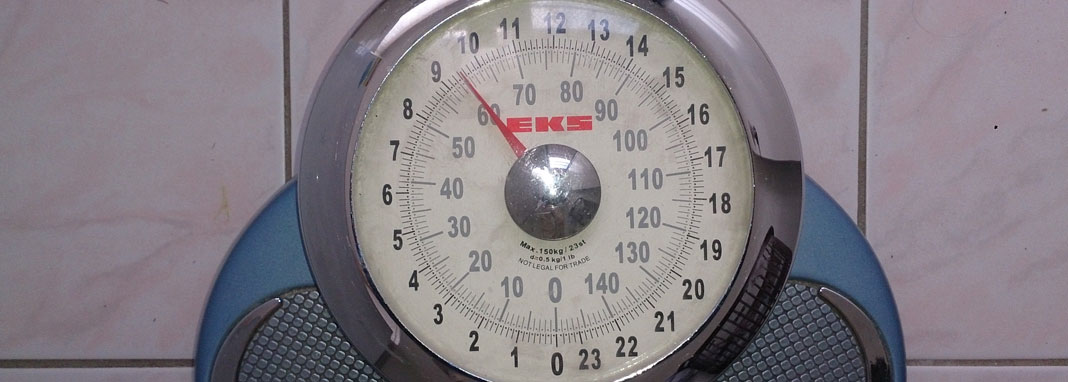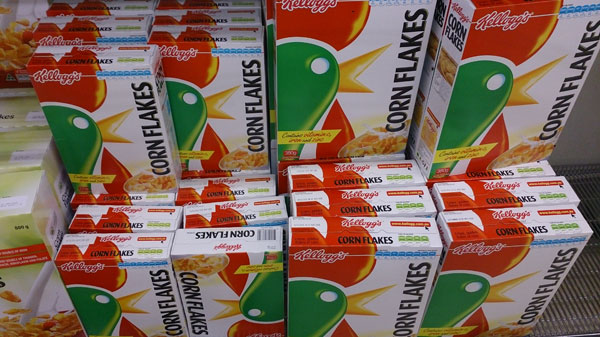We all know that if you want to go fast on a bike you need to be skinny, but why are there so many overweight cyclists?
Despite riding for hours and burning thousands of Calories, there are plenty of riders who can't shift their belly fat. They resign themselves to thinking that it is their body type, or that it is the price to pay for enjoying their food.
Losing weight does take discipline, but there is no need to go hungry or forgo delicious food. By understanding how the type and timing of food intake affects our hormones, we can lose weight with little inconvenience or willpower. By following the system below I am able to maintain sub 10% body fat all year.
Despite riding for hours and burning thousands of Calories, there are plenty of riders who can't shift their belly fat. They resign themselves to thinking that it is their body type, or that it is the price to pay for enjoying their food.
Losing weight does take discipline, but there is no need to go hungry or forgo delicious food. By understanding how the type and timing of food intake affects our hormones, we can lose weight with little inconvenience or willpower. By following the system below I am able to maintain sub 10% body fat all year.
WHY LOSE WEIGHT FOR CYCLING?
There are a few reasons why cyclists would want to lose weight to improve performance.
Going uphill
As soon as the road becomes hilly, the key metric for cycling success is your power to weight ratio. Tour de France climbers will be able to hold a ratio of over six Watts per kilo for the duration of a climb. For example, Tour de France 2013 winner Chris Froome weighs about 150lbs / 69kg and averages a power output of 400W on climbs of 30-60 minutes.
Trying to save weight off your bike is often scorned as a waste of money. In flat areas, this is true, but bike and clothing weight make a difference in the mountains. It is usually possible to drop 2kg of bike weight simply by buying a new bike, but losing 2kg of fat is not so easy. 4.4lb/ 2kg of weight loss will save you about 2 minutes up Alpe d’Huez, a climb of 6000ft in 8 miles.
Ideally you would want to lose both 4lb of fat and 4lb of bike which would save you 4 minutes, which is a considerable advantage.
Power to Drag for flat TT
On flat roads, power to weight becomes less important and the indicator of performance is power to drag. Large muscular riders do well in flat time trials as their power is high but they only have a little more drag than small guys. In such cases, weight loss is not so important.
Performance benefits due to fat burning
In this case having a low body fat percentage is an indicator of an efficient metabolism.
When you eat correctly you should be able to burn fat as a fuel source more easily. This saves your glycogen reserves for the points in the race where you need to make a big effort, such as in the final sprint.
If you eat sugar every day your body will be used to burning sugar, and will avoid burning fat.
LOSING BONE MUSCLE AND FAT
Clearly most of us would prefer to lose fat rather than any other tissue type. It is not always easy to force the body to lose only fat.
Bone
It is inadvisable to lose bone mass as this could lead to osteoporosis in later life. As cycling is weight bearing, bone density tends to drop. We often see professional riders breaking collar bones and wrists after crashing and this is assisted by low bone density.
Bone density can be maintained by weekly weight lifting. During the off season, running is an excellent activity to increase bone density of the legs and spine, but watch out for wear of the knees.
Muscle
You want your muscles to be as powerful as possible without excess weight. The trick is to lose weight without losing power.
If you don’t eat adequately, your body will quickly turn to burning muscle. You can use this to your advantage to shave some weight off your upper body since large arms and chest are not required for cycling. Some upper body muscle is helpful for sprinting but a hindrance for climbing mountains.
When weight training, work on the arms and chest no more than once per week. Use high reps - at least 10 per set and low weight. If you previously had large arms then they will easily increase in size with little stimulus so you may need to stop arm weights all together. Long bike rides will naturally remove the unwanted muscle tissue.
Since the legs are generating the power, you don’t want to lose muscle from your thighs and glutes.
Fat
Fat is generally excess weight that needs to be carried uphill, so it slows you down. This is the focus of the weight loss tips below.
Getting to under 10% body fat is easier said than done, as the body will fight to maintain its fat reserves.
Your body fat has multiple uses – as an energy store, a vitamin store, for hormonal function and to protect internal organs. A nutritionist from Cervelo Test Team told us that below 7% body fat the riders began to get frequently ill, so did not recommend trying to go lower than that.
To conclude, you want to concentrate on getting your body fat to between 7-10% for best performance.
MEASURING WEIGHT LOSS
Scales
The easiest way to measure your weight is on some bathroom scales. Since you are carrying everything uphill – bone, muscle, brain, it makes sense to weigh everything. The problem is that it is difficult to know if the weight loss is from fat or muscle.
Remember to weigh at the same time of the day, e.g. after waking and going for a wee. Try not to weigh yourself more than once a week, as weight fluctuates a lot due to fluid retention.
Visual cues
When under 10% body fat you begin to see veins on the tops of thighs and front of shoulders. Abs appear.
Calipers
Skin folds need to be taken in very specific areas. The calculation of body fat is an estimate, based on skin fold thicknesses of the overall population. As a result, skin fold tests are not an accurate way to measure body fat. Don’t buy calipers.
Underwater weighing
Subjects are weighed under water in a special tank. This allows us to calculate density of the body and therefore estimate how much of the body is fat and how much is non-fat. Numerous factors can affect the measurement, such as the amount of air in the lungs and digestive tract and ethnicity, since body fat has different densities for different ethnic groups.
It is quite reliable but will still cost around $200.
HOW LIGHT DO I NEED TO BE?
I have heard many coaches prescribing a program of substantial weight loss. For example, a 6’ / 1.83m male weighing 155lb/ 70kg was told to lose 13lb/ 6kg . Accomplishing such weight loss without loss of power would require precise medical control, which was not available. As such, he tried to limit Calorific intake, became frequently sick with coughs and colds and ruined his season.
As previously mentioned, it is not recommended to go below 7% body fat, as hormonal and immune function is compromised below that level.
It was said that Bradly Wiggins dropped to 4% body fat when he won the Tour de France. To attain such low body fat without losing power requires RER testing (see below) and a carefully constructed diet. Low body fat percentages such as this should not be maintained for long periods, but are necessary to achieve the desired goal.
Top professional cyclists represent the pinnacle of cycling performance. Such riders are carefully monitored by nutritionists and sports scientists, so they will be carrying the minimum weight without getting sick or losing power. Looking at some top riders below, we can make a few observations.
| Height m / imperial |
Weight kg/ lb |
Ratio weight/height kg/cm | |
|---|---|---|---|
| CLIMBERS | |||
| Alberto Contador | 1.76m 5’ 9.5” | 62kg / 137lb | 0.35 |
| Chris Froome | 1.85m 6’1” | 65-66kg / 152lb | 0.35-0.36 |
| Nairo Quintana | 1.67m 5’6” | 59kg / 130lb | 0.35 |
| ROAD SPRINTERS | |||
| Mark Cavendish | 1.75m / 5’9” | 69kg / 152lb | 0.39 |
| Andre Greipel | 1.84m / 6’0” | 75kg / 165lb | 0.41 |
| Marcel Kittel | 1.88m / 6’2” | 82kg / 181lb | 0.43 |
| ROULEURS | |||
| Fabian Cancellara | 1.85m / 6’1” | 82kg / 181lb | 0.44 |
| Tom Boonen | 1.92m / 6’4” | 82kg / 181lb | 0.42 |
| Peter Sagan | 1.84m / 6’0” | 73kg / 161lb | 0.40 |
| Bradley Wiggins | 1.90m / 6’3” | 69kg / 170lb (climbing weight) | 0.36 climbing or 0.38 rouleur |
| Tony Martin | 1.86m / 6’1” | 75kg / 165lb | 0.40 |
| TOP FEMALE | |||
| Marianne Vos | 1.68m / 5’6” | 58kg / 128lb | 0.34 |
We can see that top climbers have a ratio of 0.35 kg per cm of height. Sprinters and strong flatland riders have a ratio of 0.4 – 0.44 kg per cm.
The majority of amateur races tend to be run on flat or rolling circuits. A ratio of 0.4kg per cm would seem like a good target for most riders.
For example, a male of height 1.8m (5'11") would be aiming for around 72kg (159lb)if aiming to do well in the sprints and time trials, and 63kg (139lb) if aiming to win on long climbs.
The same rider would need to weigh 79.8kg (176lb) to match Fabian Cancellara. If you are familiar with cycling, then you will know that this seems heavy. When you consider that Fabian has a low body fat percentage, you can see that he is packing a lot of muscle into that Lycra!
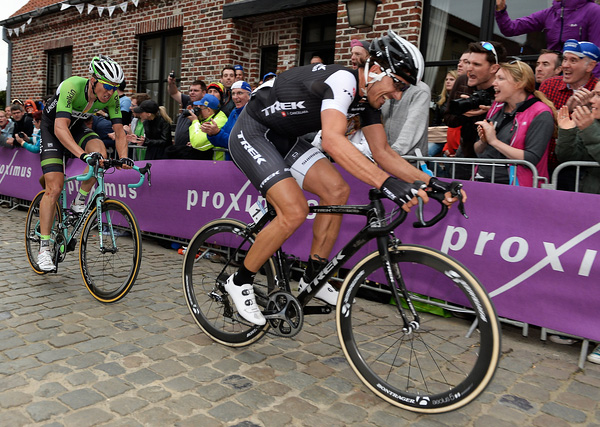
Fabian Cancellara, winner of Tour of Flanders 2014 is heavy for a cyclist, at 440g per cm, but he's the guy winning the races. Perhaps we should be gaining weight (muscle and blood) rather than obsessing about losing it.
It is a saying that climbers should aim for 2lb per inch of height, which ties in with our metric figure of 0.35kg per cm.
Remember body composition. It is no good hitting 0.4kg/cm if 25% of that is made up of fat. Also remember that weight is one side of the fraction and power is the other. You need to be able to put out 6W/kg if you want to be a world class rider.
HOW TO LOSE FAT
The traditional advice for weight loss has been to eat a low fat diet and to restrict Calories. We can see from the world's obesity epidemic that such advice isn’t working. What should we be doing?
Measuring Calorie intake and expenditure
It is very difficult to measure someone’s calorific requirements. Government advice states that a male needs about 2,500 Calories per day. However you need to adjust this for weight, body composition (muscle burns more energy than fat), activity levels, and metabolic efficiency.
You might be able to measure the energy expended on a bike ride because of your power meter, but it doesn’t give the whole story. For example perhaps it was a freezing day and you were shivering a lot. Your body was burning energy to stay warm so was less efficient at turning the pedals. Perhaps you were out of the saddle a lot which is also less efficient.
Different people are more or less efficient at turning food into pedaling. A trained cyclist might be 30% efficient whereas an office worker might be 20% efficient. The office worker would need to eat 50% more Calories to cycle the same distance as the cyclist.
It is difficult to accurately measure Calories. We are often told that fat has 9 Calories per gram. However fat actually has 6-9 Calories per gram.
Food Calories are calculated by burning the food in a calorimeter. This is not the way food is processed by the body. For example, nuts have a high Calorie count, but around one third of the Calories are not absorbed and simply pass through the gut, so nuts are not as high calorie as you might believe.
Unless you are an obsessive person who doesn’t ever eat food prepared by someone else, you can’t realistically measure and weigh every item of food you are eating.
Since we don’t know how many Calories we burned and how many we’ve consumed, how can we accurately create a calorie deficit?
The solution is to eat the correct food types and rely on our natural appetite controls in order to reach the desired weight. There is no point trying to accurately measure the day’s Calorie expenditure and intake.
A Calorie is not a Calorie
According to traditional advice, the way to lose fat is to consume fewer Calories than expended.
Since a pound of fat contains 3,500 Calories, eating 3,500 Calories less than you burn would cause you to lose a pound of fat. There is some truth to this, as overeating will make you fat no matter what you eat. It was thought that it didn't matter where the Calories came from. A thousand Calories from bread would be just as good as thousand Calories from fish.
There are a few problems with this approach:
- As we saw above, measuring energy intake and expenditure is difficult.
- Restricting Calories causes the body to sense a food shortage. The metabolism is slowed and hunger cravings begin. The need to find food is one of the most basic human instincts. You cannot fight this urge. Do not even try as you will not win.
- A typical result of Calorie restriction is to lose weight at first followed by an obsession about food, giving up the diet after a few weeks and then overeating until the weight lost is put back on, perhaps even more than before we started.
- Recent research shows that different foods have a different effect on the body. Different foods will affect blood sugar, hormones and cholesterol levels differently. For example, sugar appears to be the food source that contributes to ill health (diabetes, cardiovascular disease, cancer, gout) more than fat. The types of foods that we should be eating and avoiding are explained below.
To lose weight it is necessary to make a long term plan that you can stick to without feeling hungry or worried about food. Burning fat is a hormonal event. You must let your hormones signal to your body to release fat into the bloodstream.
Pleasure foods - aka junk food
For some reason we are programmed to adore foods which are a 50-50 mix of fat and sugar (or white flour). Such examples are a plain donuts, ice-cream, desserts, cake, crisps, boxes of chocolates. Eating such foods causes the same areas in the brain to become activated as when cocaine is taken - the reward circuit. When activated, you feel great, and this leads us to repeat the behavior, which can lead to addiction. Many foods are engineered to hit this bliss point, and are difficult to resist once you start eating them.
Food manufacturers work hard to make these foods trigger the reward circuit. We have evolved to like sugar, salt and fat, so they ensure that at least two of the three are in each product in scientifically calculated ratios.
If you try to eat pure cream, you can only eat a few spoons before it gets too sickly and you stop. Similarly, if you were to eat some spoons of sugar, you’d soon give up. If you mix the two in a 50-50 mix (like ice cream) then you can easily eat a lot.
The best way of avoiding these foods is to not buy them. If they are not in your kitchen then you will not be bothered to make a special trip to get them, and will eat something to hand which is healthier, such as some fruit or nuts.
To not buy these foods you will need the entire family to follow the system. If your partner is filling up the cupboards with crisps and snacks then your diet will be doomed. Don’t go shopping if you are hungry (e.g. straight after a ride) as it will be difficult to resist buying some junk food treats.
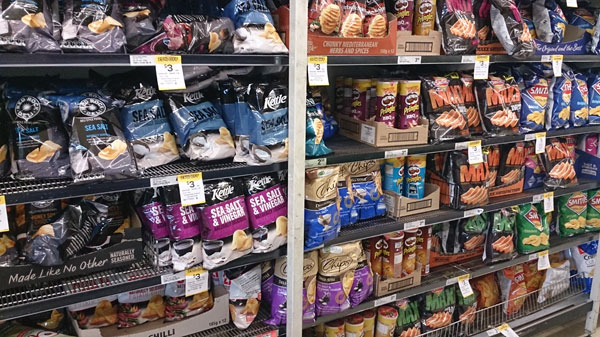
Chips/ crisps should be avoided by cyclists as they are high in salt, high GI, high in bad fats, low in nutrients and they taste incredible (with just the right crunch) so you can easily eat a whole bag of them which is around 800 Calories.
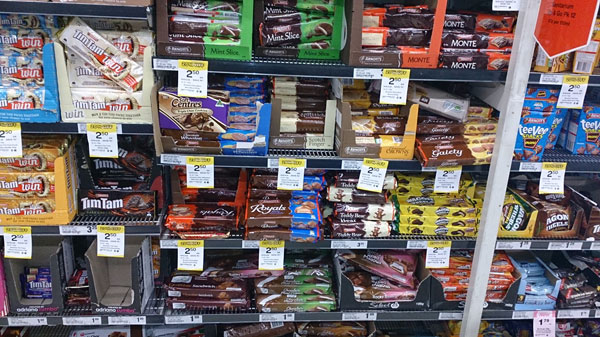
Again these sorts of treats contain a lot of sugar and fats (usually of the bad kind), are low in nutrients, but are very tasty, so you can easily overeat. This food is best avoided.
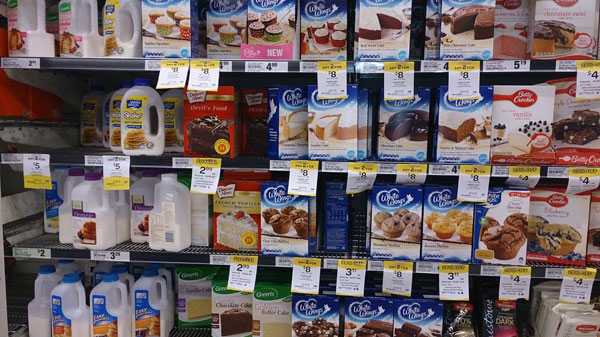
Could be useful during exercise or for rapid refueling afterwards, but at other times should be avoided.
You should also avoid ordering take-out food. Such food (pizza, curries) is high in fat, sugar, salt and starch. It has high cravability and you can easily wolf down massive servings of these foods which will lead to weight gain. Once the hot food is in your hands there is no easy way of resisting it, so your best chance is to not order it. Throw away the coupons and menus, make time to stock up on wholesome foods so when you need to eat you have something available.
Sugars
(Sucrose, Glucose, Maltose, dextrose, but also starch like white flour, potatoes).
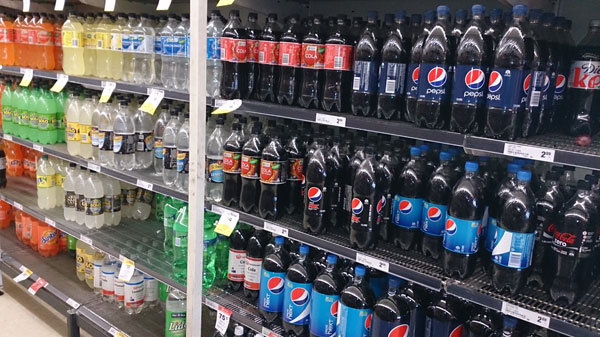
Sugary drinks are very handy during intense exercise, but should be avoided at other times due to the high sugar - and surprisingly - salt content. The carbonic acid is dissolves your teeth and sugar-free versions have unknown side effects, despite being passed as safe for health. Most sodas contain High Fructose Corn Syrup (HFCS) which is a combination of glucose and fructose, so it delivers twice the punch.
Sugar has been getting a lot of bad press recently. See this book: Fat Chance: Beating the Odds Against Sugar, Processed Food, Obesity, and Disease
When sugar is consumed through the day, the body eventually becomes insulin resistant. The action of the appetite regulating hormones ghrelin and leptin are also suppressed, which causes an inability to stop eating and food cravings. Immune function is negatively affected and the end result is weight gain and a body that will only burn sugar as a source of energy. For health and endurance performance this is a disaster.
While Lustig’s arguments are compelling, experiments show that a pure sugar diet doesn’t cause weight gain. The test subjects were not healthy, but did not become wildly obese. Dr Lustig himself is a bit fat, despite avoiding sugar.
A fat and sugar mix is the main cause of weight gain. Remember – the food industry works hard to create products that hit the bliss button, so you will buy them more frequently and eat more.
For cyclists, sugar is an excellent source of energy during exercise as it is easily absorbed and used by the muscles. When not exercising or on rides shorter than 90 minutes, sugar should be avoided.
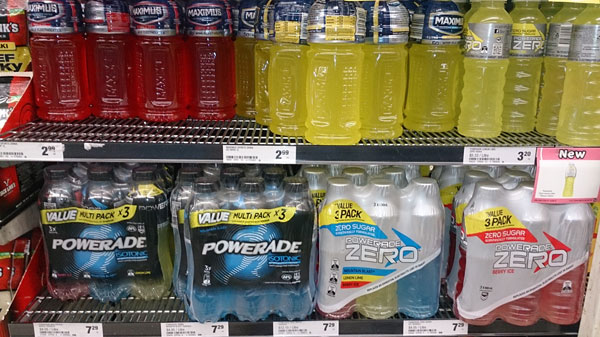
These drinks are full of sugar which is excellent during intense exercise, but should be avoided when at rest, before events, or on rides shorter than 90 minutes. People are buying these to drink at the gym, when all that is required is water.
Fructose
Fructose is a form of sugar found in fruit and honey. Fructose is metabolized by the liver and not by the gut as with other sugars. This different digestion path means that fructose doesn’t have the same effect on insulin levels as glucose, which means it is not a high GI food. People think this means it is healthy, so may consume it without limit.
Fruit is good to eat as it contains fiber to match the fructose. The fiber slows absorption of the fructose and limits how much we can eat. For example, you’d rarely eat more than two oranges. When the fiber is removed or pulped, far more fructose can be consumed and its absorption is not slowed. The liver gets a large hit of fructose and this is damaging to it and your body. The rapid metabolism of fructose in the liver and resultant drop in hepatic adenosine triphosphate (ATP) levels have been linked with mitochondrial and endothelial dysfunction, alterations that could predispose to obesity, diabetes, and hypertension.
Fruit juice and smoothies should therefore be avoided except during or immediately after exercise.
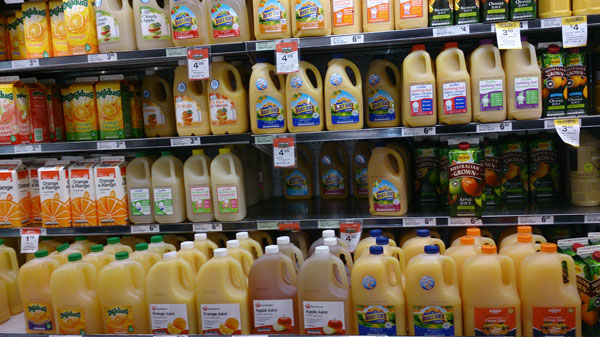
Fruit juice delivers a large amount of fructose in a short space of time as the fiber has been removed or pulped. As a result, the liver gets overwhelmed and can become damaged. Meanwhile, the rest of your body is negatively impacted. It should only be consumed during or immediately after exercise.
Alcohol
There is nothing wrong with a few beers here and there, especially after training. Just remember that beer contains maltodextrin, which is a double dose of sugar. (It is two glucose moleclues combined). Cider and cocktails often contain a lot of sugar. Getting drunk often leads to ordering take outs or eating kebabs or bags of chips, which leads to weight gain.
Red wine or vodka contain very little sugar, so is a better choice if you have to drink socially. Alcohol is processed in a similar way to fructose and the liver can cope with it in small quantities.
There is no need to go teetotal, but regularly drinking beers and shots won’t make you skinny (unless you become alcoholic). If you want to cycle well you’ll need to cut back.
Note that alcohol consumption can disrupt the body's ability to control sugar, which can lead to a faint. It should not be consumed during riding if you want to keep riding fast.
Other Carbohydrates
Cyclists do need to eat carbohydrates if they want to ride at a decent effort level. If you cut out most carbs (such as on an Atkins diet), you will lose body fat, but you will enter what is called ketosis. Your body will be using fat as a fuel, which is fine for slow, steady effort like walking. However if you need to sprint up a hill, you will need to use glucose for energy. Since none is available, you will have no top end speed at all. More information about low carb high fat diets in this article.
If you are very overweight, then cutting out most carbs from your diet makes sense as it will produce the most rapid weight loss, and that would be the main focus.
If you are already of normal weight and are training for speed, then you need to eat carbs, otherwise you will feel extremely sluggish on the bike. It would be like trying to run a race car on heavy oil.
You should try to eat carbs that have a low GI. Oats are good, so is whole fruit, lentils, vegetables - anything fibrous which slows the absorption of sugars.
Try to avoid or minimize refined starches such as white bread, white pasta, sweet cereals and white rice. These have a high GI, so will mess with your metabolism as explained above. They make excellent foods to eat whilst racing, however.
Fat
Fat has been vilified by nutritionists as it contains more Calories per gram than carbohydrates or protein and it has been blamed for heart disease.
This would make sense if we lost weight simply by Calorie control, however as mentioned above, the type of food eaten is more important than the quantity. Many low fat diet products have been produced, with sugar as the substitute for fat. These foods are a bad for health as they taste bad, the sugar is bad for us (see above) and they don’t fill us up. There is no evidence that good fats cause heart disease.
If you eat a meal which contains natural good fat, then it will taste great. You will feel like you ate something wholesome, you won’t feel hungry afterwards and the fat will boost your hormonal and immune function.
Fat is a natural and essential part of our diet. These healthy fats, when eaten in their natural forms (i.e. not with added sugar) make you fat. As explained above, adding sugar to fat allows you to easily overeat.
Team Sky riders eat a minimum of 100g of fat per day. That’s around 600-900 Calories from fat, or around a quarter of their food intake.
Care need to be taken to eat ‘good’ fats and to avoid manufactured fats.
i.e. Eat Omega 3 in preference to Omega 6 in preference to Omega 9 and transfats. Omega 3 and 6 fats can’t be made by the body, which is why we need to eat them. Omega 9 fats can be made by the body so you don’t need to eat them and transfats are bad for you as the body finds them hard to process so they end up coating the insides of your arteries.
Good fats can be found in grass fed meat, coconuts, avocados, eggs, olive oil, nuts, butter, full fat milk and oily fish such as salmon and kippers. Saturated fats are not bad and are used by the body as a source of energy.
The bad fats are found in crisps and chips, pies, margarine, cheap ice cream chocolates and fast food.
You should replace some of the energy you get from carbs with energy from good fats. You will feel a lot healthier for it and it will help with weight loss.
Protein
Cyclists undergoing heavy training should consume about 2-2.5g per kilo of body weight per day. This equates to a lot of protein, about 5-6 chicken breasts of 5oz/150g each for a 155lb/ 70kg man. Fish and chicken are more easily used by the body than red meat. Mark Cavendish tends to avoid red meat for that reason.
For those who can process lactose, milk and whey powder are good sources of protein.
Do consider your gut health when eating that much protein. It can be maintained by balancing the protein intake with a consumption of fresh vegetable juice (see below).
Fiber
Fiber is also vital for digestive and metabolic health for a few reasons.
It slows the absorption of sugar from what you’ve eaten. If you make a smoothie, the fiber is shredded, which means that the entire sugar load of the fruit is delivered quickly to your liver. This can be handy if you are in a bonked state (hit the wall) but the rest of the time it is very bad for your liver and body.
The fiber also fills you up, so you won’t consume as many Calories. (See above – you might eat one or two whole oranges but can easily drink the juice of six oranges).
Fiber is also vital for the bacteria in your gut. Research shows that the bacterial composition of the gut seems to be a factor that promotes weight gain. Fiber seems to make the good bacteria thrive (along with gas), and keeps the obesogenic bacteria at bay.
HOW TO GET DOWN TO 15% BODY FAT
1) get out and ride the bike. You don’t need to ride hard, just keep the pedals turning over at level 1 or 2 (find out about your levels here). If you can manage to ride for a few hours at a time, then do.
If you ride harder you will risk burning yourself out and also injury. Be gentle on your body. You can work on speed and power once you are fitter.
Ride regularly – four to five days per week and to keep doing that for a stretch of several months. Allow for easier rest weeks every 2-3 weeks.
Prepare your food before you go on a long bike ride. When you come home you will be starving and if you open the food cupboard and find a pack of biscuits, then you are going to eat half the packet before you have even thought about it. Prepare fish, rice and broccoli. It might look unappetizing before you go cycling but when you return some hours later, it will seem like fine dining.
Ensure you maintain a good intake of protein. Eat a portion in the morning, such as eggs or kippers, some for lunch such as chicken and a little for dinner. Snack on plain nuts. Fish and chicken is a better source than red meat as it is easier for the body to digest. If you do not maintain protein intake then your body will burn muscle in preference to fat. You will lose power while still being fat which is not the desired outcome.
Allow yourself treats and blow-outs every few weeks. You are not in a prison camp, you are trying to drop some weight in order to cycle faster and be healthy.
How long will it take?
Expect to keep at this regime of long, steady riding and healthy food for at least 6-12 months. By that time your body will have adapted to the exercise and your metabolism will have steadied to a healthier state. You may need two years if you were over 30% body fat at the start.
GETTING FROM 15% TO 10% BODY FAT
Many racing cyclists are in this range. They are quite thin, but may have a bit of a belly or lack of definition.
They will be thinking that they do so much exercise that they can eat anything they want.
The errors here are:
1) Over consumption of high GI carbs such as pasta and white bread, in large quantities.
2) Over consumption of pleasure foods such as cake, crisps, cookies, donuts, juice, beer.
3) Under consumption of protein and fat which assists with rebuilding after exercise.
4) Under consumption of vegetables for nutrients, fibre and alkali gut balance.
5) Over estimation of Calories required.
The ability to burn fat is compromised by the high GI intake at rest. Over consumption of Calories is easily accomplished due to eating pleasure foods. A stressful job or over training may be causing cortisol release which leads to putting on belly fat.
If you would like to lose a bit more fat then you need to adjust your diet, but you don’t need a major overhaul, so the changes should be easy to accomplish:
- Do not buy or stock pleasure foods. This means cake, crisps, cookies, soda, alcohol etc. - Drink water when thirsy, not juice or soda.
- Reduce the amount of carbs you eat. If you are fit, you are more efficient at converting food into pedaling motion, so food guidelines for normal people don’t apply. You need carbs, otherwise you will not be able to cycle at anything over effort level two. Take your carbs from fruit, vegetables and brown rice, lentils, quinoa.
- Eat more good fat. You need to make a conscious effort to buy foods with good fats. This fat will replace the energy of the carbs you have cut back on.
- Eat protein through the day, especially for breakfast. This will stop muscle wastage and will allow you to lose fat without losing muscle.
- Don’t starve yourself or count Calories. The fat loss will happen due to change in diet rather than conscious Calorie restriction.
If you follow the principles above, you will get down to 10% body fat. You’ll see definition on your abs, you might start seeing veins popping up in new places like the tops of your thighs and shoulders. People will ask you in a concerned tone if you've lost weight.
Best of all, you will become better at burning fat. You will suddenly find yourself with the front riders and not blowing up after three hours of hard riding.
GETTING BELOW 10% BODY FAT
To get below 10% body fat is more complicated than simply avoiding junk foods. The main difficulty is to lose the body fat without losing power. You can’t go on an Atkins Diet like a body builder as you need carbs to ride at high intensities.
In order to drop below 10% body fat, eat smaller portions of carbs than you are used to. At this stage, your body is getting efficient, so requires fewer carbs than you might expect. Limit intake to a moderate portion of pasta or rice. Don’t go back for seconds.
People with the time and resource could have a lab test done to find out what percentage of carb to fat is being burned at varying exercise intensities. This is accomplished by analyzing exhaled gases (RER test). You can then map carbohydrate intake to energy expenditure through the day, ensuring that not too much is consumed, which would be turned into fat. This is the method used at British Cycling, and shows just how finely tuned the diet can be to get the very low body fat percentages.
Maintain intake of good fats. These are needed for your immune system and hormones and will make your food taste a lot better which will make you less likely to overeat.
Go on long training rides. 6-7 hour rides force your body to burn fat. It works better than any other short cuts. The only downside is that it takes up a lot of time.
To avoid muscle wastage, eat a good quantity of protein. This means about 2 - 2.5g per kilo of body weight. Example: 155lb/ 70kg male, eat 5 - 6 breasts of 5oz/ 150g each per day.
Do not go riding on an empty stomach in an effort to burn off more fat. A popular protocol would be to drink a large cup of black coffee then go for a long ride, drinking only water. As explained to me by Cervelo Test Team’s nutritionist, your body will turn to burning muscle in preference to fat, so you will end up losing strength and power. To avoid this, ensure you eat some protein before riding, such as fish or eggs, which are easily digested. Especially try to have some protein for breakfast.
Eat protein for each meal and snack on it between meals. Protein powder and milk are good sources of protein for those who are not lactose intolerant. Avoid soya protein.
Eating so much protein is not good for your gut chemistry and can result in bloating and malabsorption of nutrients. To counteract this, you need to eat vegetables. The easiest way to get the nutrients without the bulk is the juice them. Someone eating 175g of protein per day might need 1-2 liters of vegetable juice. Good vegetables for juicing are celery, beetroot, carrots, broccoli and spinach. Carrots are quite high in fructose, so don’t drink too many. Avoid fruit juice as this contains too much fructose.
Eating a few cheeseburgers now and then will stop you craving them so much the rest of the time.
Remember that you are carefully monitoring your diet in order to perform better at cycling. The norm in society is to be overweight, and those people around you will try to make you uncomfortable about your diet to make themselves feel better. Your best tactic is to smile and let such comments wash over you. You have control of your life and health more than they do over theirs.
Below 7% body fat
Unless you are under medical supervision, it is not advisable to go below 7% body fat as you will suffer from frequent colds and will likely lose power. Very low body fat percentages should not be maintained for long periods.
CONCLUSION
Many cyclists want to lose weight and many find it difficult to do despite spending hours in the saddle.
Cyclists need to lose fat and some muscle (such as upper body muscle) but not lose power.
For everyone, the first step is to cut out processed foods such as cake, crisps, cookies, donuts and soda. Combined with cycling, this will be enough to get you to 10-15% body fat.
If you want to go below 10% body fat, you need to ensure that you are eating enough protein to avoid muscle wastage and just enough carbs to fuel your training. Your body will become so efficient that you will eat less than you did before. Food quality is important to maintain nutrient levels.
Don't try to go below 7% body fat unless you have a medical team behind you, as the likelihood is that you will lose power and get sick.
As you lose fat, you will start to see the benefits, particularly in hilly events. Good Luck!
Links
Fat Chance: Beating the Odds Against Sugar, Processed Food, Obesity, and Disease
Interesting dietary advice, not only concerning today's over consumption of sugar. There's plenty of advice on what we should be eating. Cyclists should modify some of the advice in the book. For example, he states that only Olympic athletes would ever get close to running out of liver glycogen. He's clearly never tried cycling a hundred miles.
It is interesting to note that this book used to be called Fat Chance - the bitter truth about sugar. Presumably the publishers were threatened with legal action.
Why We Get Fat: And What to Do About It
Taubes tries to explain the obesity epidemic from more of a logical, common sense point of view rather than a scientific point of view. For example, the Inuits eat a lot of fat but don't get fat, so he concludes that eating fat is okay. To be fair, he does present research to back up his conclusions. There is a lot of useful and though provoking information in the book concerning diet.
The Paleo Diet for Athletes: The Ancient Nutritional Formula for Peak Athletic Performance
There's a lot of useful information in this book, and I agree with the main message to cut out processed foods. There's something in this diet that seems slightly fanatical, nevertheless, it is a useful book to cherry pick advice from.
comments powered by Disqus
